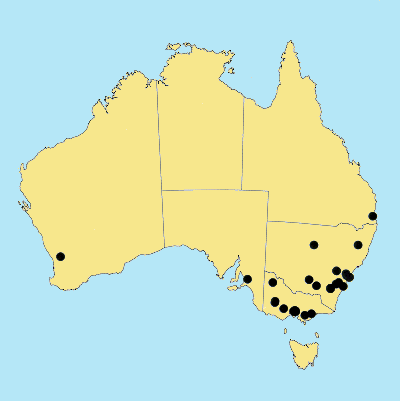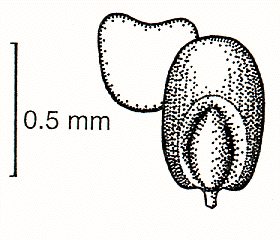Eragrostis mexicana* (Hornem.) Link. Hort.
Reg. Bot. Berol. 1: 190 (1827).
Classification. (GPWG 2001) : Subfamily
Chloridoideae. Cynodonteae.
Basionym and/or
Replacement Name: Poa mexicana
Hornem., Hort. Bot. Hafn. 2: 953 (1815).
Type of Basionym or
Protologue Information: ST: Sessé s.n., Cultivated from seed
collected in Mexico (MA).
ST: Sessé & M. Lacasta,
Brazil (US-2891498 (fragm)).
Recent synonyms:
E. neomexicana, E.virescens.
Key references
(books and floras): [2002] D.Sharp & B.K.Simon, AusGrass, Grasses of
Australia,
[2006] J.Jessop, G.R.M.Dashorst, F.M.James, Grasses of South Australia
(376), [2008] S.W.L.Jacobs, R.D.B.Walley & D.J.B.Wheeler, Grasses of New
South Wales (254).
Illustrations:
[2005] K.Mallet (ed.), Flora of Australia 44B: Poaceae 3
(Fig. 68U-V), [2006] J.Jessop, G.R.M.Dashorst, F.M.James, Grasses of South
Australia (376, fig. 308), [2008]
S.W.L.Jacobs, R.D.B.Whalley & D.J.B.Wheeler, Grasses of New South Wales,
4th edn (254).
Habit. Annual.
Culms erect or geniculately ascending or decumbent, 12–120 cm tall.
Leaf-sheaths hairy. Ligule a fringe of hairs, 0.5–0.8 mm long. Leaf-blades
straight, lanceolate, flat or involute, 5–30 cm long, 3–10 mm wide. Leaf-blade
surface glabrous or indumented.
Inflorescence.
Inflorescence compound, a panicle. Panicle ovate, dense or loose, 10–40 cm
long, 4–8 cm wide.
Spikelets.
Spikelets sessile or pedicelled. Fertile spikelets many flowered, with at least
2 fertile florets (5–16), comprising 5–16 fertile floret(s), with diminished
florets at the apex, linear or lanceolate or ovate, laterally compressed,
3.5–9.5 mm long.
Glumes. Glumes
similar. Lower glume ovate, membranous, keeled, 1-keeled, 1 -nerved. Upper
glume ovate, 1.8–2 mm long, membranous, keeled, 1-keeled, 1 -nerved.
Florets.
Fertile lemma 1.6–2.5 mm long, keeled, 3 -nerved. Anthers 3. Grain 0.2–0.6 mm
long.
Continental
Distribution: Africa, Australasia, Pacific, North America, and South America.
Australian
Distribution: Western Australia, South Australia, Queensland,
New South Wales, Victoria.
Western
Australia: Avon. South Australia:
Southern Lofty. Queensland: Wide Bay,
Darling Downs, Moreton. New
South Wales: North Coast, Central
Coast, South Coast.
Victoria:
Gippsland Plain.
Notes.
Escape, weed.
Distinguishing characters include erect or
decumbent annual, with usually flat closely nerved blades and subterete lower
culms; partly exserted, loose panicle large relative to plant length;
stipitate, rectangular, concave or grooved, strongly reticulate caryopsis.
Introduced;
recorded from the Northam area, W.A., around Adelaide,
S.A., Indooroopilly, Qld,
scattered in N.S.W. from Doonside to Nowra and inland near Nyngan, and
Gippsland and Melbourne areas, southern Vic.;
native to southern United States of America,
Mexico, Central and S
America, introduced in Australia
and S Africa. Introduced in Australia, an
escape from experimental plots or weed of habitation.; flowers Jan.-May,
Aug.-Sept.; fruits Jan.-May, Aug.-Sept.






